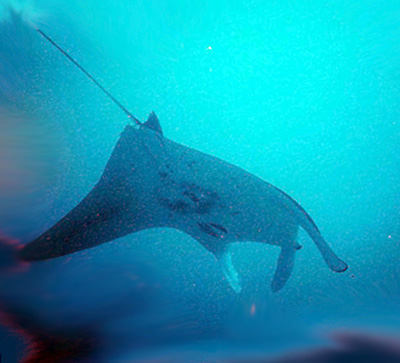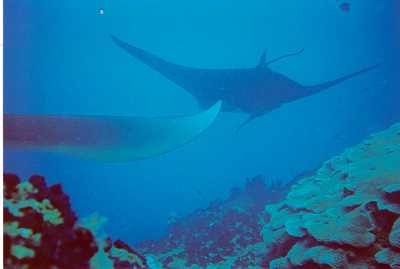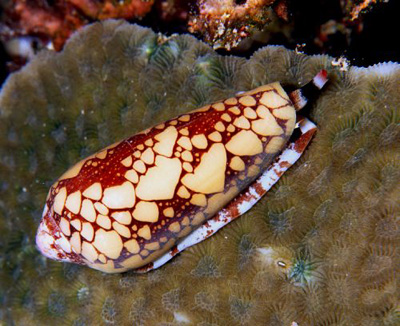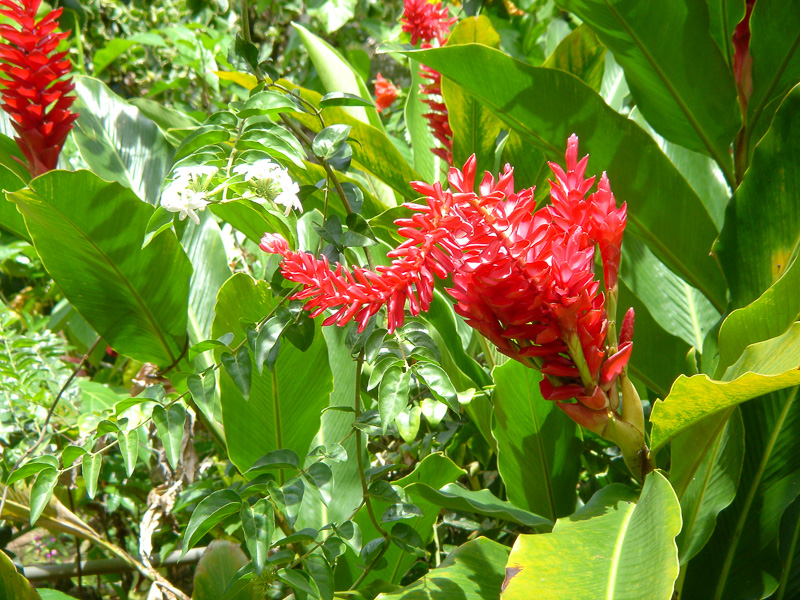This morning Embry and I went for one last manta dive . We left early, were the first at the site, and glimpsed a manta in the water before we jumped in. Our guide was Stahmp, a native of Chuuk who moved to Pohnpei to live with his local wife, he was mellower than the Japanese dive master we had the first day out.
We dropped down to a sandy crushed-coral bottom at about fifty feet, crept up into a couple of coral heads, and there they were, two mantas, both dark on top, one light on the bottom, and the other dark on the bottom, which is unusual. They were hovering over these coral heads to be cleaned by wrasses, these wriggly little-finger-sized fish with three stripes along their length, the wrasses make their living by nibbling the parasites off other fish and off mantas as well. The other fish like this, they seek out the wrasses, the coral heads with wrasses in them are called cleaning stations.

The mantas were just as alien as I'd hoped. Incredibly streamlined, all about curvature and torsion, a body roughly the shape of a sea turtle, but with meaty triangular wings going out on either side, a rudder-type fin near the rear, a long spike at the very back. They were ten or twelve feet across. Their eyes are in protruding knobs at either side of their heads, not that they really have a separate head, “anterior end” might be more appropriate. They have a slit mouth they can open to be fairly big and round so as to suck in water; they're filter-feeders. They have a pair of little appendages sticking out of the sides of their heads, fleshy and oar-like rather than fin-like. Sometimes one of these would be rolled up, but usually they were sticking out, gently adjusting themselves to the current, playing a role, I suppose, analogous to an airplane's horizontal stabilizer fin at the rear. They had five gill slits down either side of their chests; they opened up the slits like lipless mouths, and the cleaner wrasses were in and out of the slits, worrying the skin, also busy along the rear edges of the mantas body. Occasionally a wrasse would nip too hard, and the manta would twitch it loose. They raised up and lowered down several times, once the white one was up overhead and released a nasty and alarmingly large cloud of poop; the nearby fish were all over that, of course. The black one was close enough to me that I could have touched it, had my arm been twice as long. A very, very satisfying experience.

Afterwards we did another long shallow dive along a reef of soft corals, loaded with fish, probably my last dive in Micronesia, I was nostalgic for it already, saying goodbye the corals and fish, the pale green and pale lavender disks with the fractally folded edges, the brilliant yellow guys, the little guys who are green or gray or blue depending on the light and all these shades so lovely and watery and gleaming, the school of twenty tiny damselfish each one a different size like a line of carved ivory elephants hovering over the chartreuse (yellow-green) single-trunked flat-topped forest of fire coral, the last nudibranch with black body and yellow edge and red chemical sensor antennae and red tree-like naked gill growing out of his back, the last parrot fish, goodbye, Micronesia diving, goodbye.
I did sixteen SCUBA dives in all.

The people diving with us were fascinating, Scott and Jeanette Johnson, regular contributors to the Sea Slug Forum, and biologists turned tech workers for the US missile range at Kwajalein in the Marshall Islands east of here, which also a part of the archipelago of Micronesia, although not part of the Federated States of Micronesia. They knew all about cone shells, in fact they’ve made several great videos of Micronesian sea life. (That cone picture above is by the Johnsons.) Yes, the cones do live here, but I haven't seen them because they spend most of the day buried under a shallow layer of sand and come out to hunt at night. There are three groups, one eats algae, one eats other shell-creatures such as cowries, snails and cone shells, and the baddest mofos of all eat fish. I think they said Wolfram's textile cones fall in the second category, but I'm not sure about the tent cones, who have simpler looking patterns. They said once they'd caught a tent cone and put it in a bucket and they irritated it so they could watch it lashing out and firing poison dart after poison dart. They said if you find an empty cowrie shell, that means a textile cone ate the poor cowrie. By the way, Scott found a nice empty “map cowrie” shell for me. They're also big fans of giant clams, Jeanette said she has hundreds and hundreds of photos of their mantles. They said the Solomon Islands are good place to see cuttlefish and cone shells. So now I want to go there too, although I think Sylvia's up for Tahiti next, which would be good, too.

More cone shell info from the biologist divers another day. The cone has a proboscis that sticks out from inside its mouth, and the stinger is in the proboscis. When eating a fellow mollusk, the cone slimes its mouth tube inside the victim's shell, engulfing it in situ. The proboscis is red. When a cone eats a fish, what you find the next day is a little pack of bones wrapped in mucus. They're such nasty little beasts. Great article about them in the latest Scientific American, by the way, and you can find lots more the Cone Shell and Conotoxins web site. I happened on a book about cone shells at the beach in Sanibel just now. They’re closing in on me!
I’ll use cone shells for the bad guys in my novel, and maybe in a story as well. What a great horrific image. A cone shell is hiding under the sandy dirt of the pumpkin patch in the backyard of someone's house in Santa Cruz, with only its vigilant proboscis protruding, and it creeps out at night and eats this guy, and then all that can be found the next morning is his bones wrapped in mucus. Resting on his pillow. Gary Ziff: parrothead, stoner, termite inspector, R. I. P.








